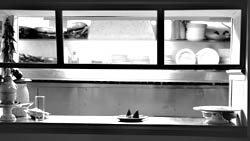I spent a good chunk of March in Spain, standing at chest-high tables, drinking little glasses of beer and scarfing down things with pork in them while eavesdropping to improve my Spanish. It was a good vacation, and much about Gaudí, Joan and Jo Luna’s Spanish restaurant near University Village, reminded me of it.
Gaudí’s like one of those little family-run bistros you eat in all over Europe. Though just six months old, it has the settled-in, comfortably frumpy ambience of a place that seems to have been occupied for years. The walls display pictures and mementos that the Lunas brought over from Spain, including a massive stained-glass window from the skylight in the couple’s old Barcelona restaurant. When you walk in, half of a mustache and one brown eye peer out from the window of the tiny kitchen, sizing you up and then disappearing again. The chef’s wife runs the dining room like the host of a dinner party, loose and comfortable.
Gaudí’s menu showcases tapas and paella, with all of the salt cod and roast peppers you could hope for. As long as you’re not talking about the molecular gastronomy that celebrity chef Ferran Adrià and his acolytes have gifted to the world (think Marcel from Top Chef), Spanish food isn’t looks-first, and Luna presents his tapas in authentically humble style—a crisscross of lamb skewers on a white plate, a small brown cazuela containing five tail-on prawns.
It’s food that’s meant to be tasted, with flavors a mile deep. The meat on the pinchos morunos, or “Moorish skewers,” is rubbed with a pungent cumin-garlic marinade that stains the meat yellow. The prawns in the gambas pil-pil loll about in a pool of olive oil, garlic, and chiles. Fat mussels are pickled and served with a paprika-sherry vinegar sauce. Luna takes his tortilla (potato-onion omelet) and layers it with sauteed spinach and roasted peppers, frying the eggs in what I suspected was chorizo fat to give them an unexpectedly welcome smokiness. And one of his daily specials, a classic Barcelona tapa fittingly called a “bomba,” was deeply satisfying in a scotch-egg sort of way: tangerine-sized balls of ground meat and mashed potatoes rolled in lacy Japanese bread crumbs, deep-fried, then blanketed in chile-pink aioli.
Later courses taste just as good. A wild boar stew, presented in a cast-iron pot, frames the meat’s gaminess in tart red wine and sharp red onions. A tart filled with thick quince jam would be unbearably rich were it not paired with a cylinder of whipped, unsweetened ricotta, an ideal counterpart.
Luna’s classic chicken, rabbit, and chorizo paella, which you must order in twos or threes, is the perfect marriage of style and substance. (He also makes a seafood paella and fidua, a Catalan variant with skinny noodles instead of rice.) The round pan comes to the table straight from the oven, its metal handles protected with yellow paper bows, baked rice ornamented with stripes of red pepper and a whole head of garlic. Each time I scooped out bits of the bright-gold, chewy rice, sweet roasted garlic cloves slipped out of their skins and amplified the flavors of saffron and tomato.
The worst dishes I tried over the course of my two visits were salads—a weakness that may be just as authentically Spanish as the strength of Gaudí’s fried food. The ensalada jitana, with potatoes, black olives, salt cod, onions, and orange slices, could have been good without either the big boiled potato chunks or the sweet citrus fruit; reconciling the two flavors was like trying to straddle a road as it forked. The ensalada Gaudí, a chopped salad with ingredients as divergent as cilantro, papaya, and green peppers, had a few too many ingredients; it might just be great in a couple of months, however, when the tomatoes and cucumbers hit their full summer potency and pull the rest of the ingredients in line.
Serving the food of his homeland is actually a radical departure for the chef. Joan (his name is the Catalan variant of Juan) was born into the restaurant business in Spain, but the Barcelona bistro that he and his wife, Jo, owned for a decade only served “international cuisine.” They put a jack-o’-lantern out front at Halloween and drew a crowd of North American expats for Thanksgiving dinner. After relocating to Seattle, however, the Lunas abandoned culinary fusion in favor of faithful renditions of specialties from around the country.
But the transition isn’t seamless. In Spain, as in much of Europe, people gather at bistros exactly like Gaudí for affordable weekday dinners, which they expect will include several courses, wine, and (gruff) service. In the States, when we want a casual dinner with friends, we’ll hit a brew pub or Thai restaurant; bistros, with their multiple courses and white tablecloths, are for special events. While I don’t consider Gaudí’s prices exorbitant, a nongluttonous meal there does cost $40 a person, which is the cost of a celebratory night out for me. Juan is a talented cook and Jo a great host, but if they’re going to be that kind of bistro, they should hire bussers and assistant servers who don’t look quite so befuddled, and should consider polishing up their presentation. Even though the small-plates trend here evolved out of tapas, a meal of $8–$10 small plates in America doesn’t just mean serving double portions of traditional Spanish bar snacks; it means composing each plate artfully and serving it with a little more panache.
One last request: bread on the tables. So many fantastic sauces, so little to sop them up with. If the napkin hadn’t been starched linen, I would have used it to soak up the good stuff and wring it into my mouth.







